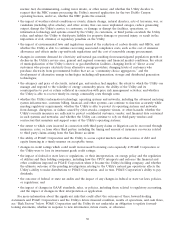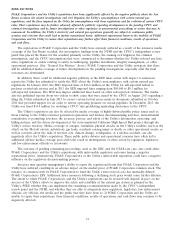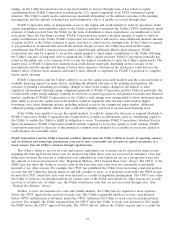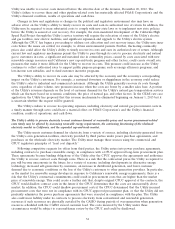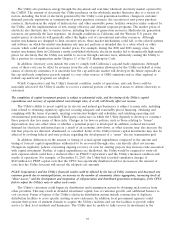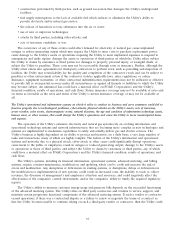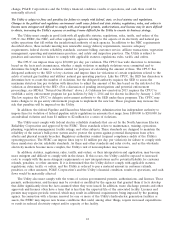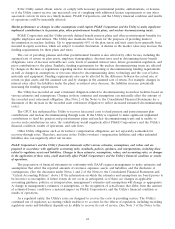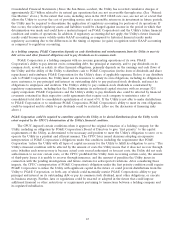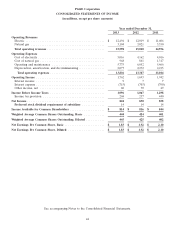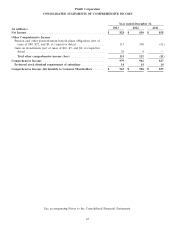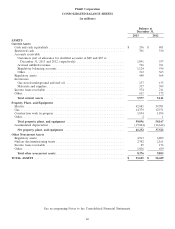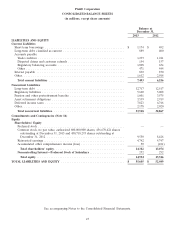PG&E 2013 Annual Report Download - page 46
Download and view the complete annual report
Please find page 46 of the 2013 PG&E annual report below. You can navigate through the pages in the report by either clicking on the pages listed below, or by using the keyword search tool below to find specific information within the annual report.of natural resources and wildlife. The Utility can incur significant capital, operating, and other costs associated with
compliance with these environmental statutes, rules, and regulations. These costs can be difficult to forecast because
the extent of contamination may be unknown. For example, the Utility’s costs to perform hydrostatic pressure tests
on natural gas pipelines were higher than anticipated because the water used to perform the tests became
contaminated as it traveled through the pipe and the Utility had to incur additional costs to remediate the
contaminated wastewater. Further, even if the extent of contamination is known, remediation costs can be difficult to
estimate due to many factors, including which remediation alternatives will be used, the applicable remediation
levels, and the financial ability of other potentially responsible parties. Environmental remediation costs could
increase in the future as a result of new legislation, the current trend toward more stringent standards, and stricter
and more expansive application of existing environmental regulations. Failure to comply with these laws and
regulations, or failure to comply with the terms of licenses or permits issued by environmental or regulatory agencies,
could expose the Utility to claims by third parties or the imposition of civil or criminal fines or other sanctions.
The Utility has been, and may be, required to pay for environmental remediation costs at sites where it is
identified as a potentially responsible party under federal and state environmental laws. These sites, some of which
the Utility no longer owns, include former manufactured gas plant sites, current and former power plant sites, former
gas gathering and gas storage sites, sites where natural gas compressor stations are located, current and former
substations, service center and general construction yard sites, and sites currently and formerly used by the Utility for
the storage, recycling, or disposal of hazardous substances. Under federal and California laws, the Utility may be
responsible for remediation of hazardous substances even if it did not deposit those substances on the site. Although
the Utility has liabilities for known environmental obligations that are probable and reasonably estimable, estimated
costs may vary significantly from actual costs, and the amount of additional future costs may be material to results of
operations in the period in which they are recognized. (See Note 14 to the Notes to the Consolidated Financial
Statements for more information.)
The CPUC has authorized the Utility to recover its environmental remediation costs for certain sites through
various ratemaking mechanisms. One of these mechanisms allows the Utility rate recovery for 90% of its hazardous
substance remediation costs for certain approved sites without a reasonableness review. The CPUC may discontinue
or change these ratemaking mechanisms in the future or the Utility may incur environmental costs that exceed
amounts the CPUC has authorized the Utility to recover in rates.
Some of the Utility’s environmental costs, such as the remediation costs associated with the Hinkley natural gas
compressor site, are not recoverable through rates or insurance. The Utility’s costs to remediate groundwater
contamination near the Hinkley natural gas compressor site and to abate the effects of the contamination have had,
and may continue to have, a material effect on PG&E Corporation’s and the Utility’s financial conditions, results of
operations, and cash flows. (See ‘‘Environmental Matters’’ above.)
The Utility’s future operations may be affected by climate change that may have a material impact on PG&E Corporation’s
and the Utility’s financial condition, results of operations, and cash flows.
A report issued in 2012 by the EPA entitled, ‘‘Climate Change Indicators in the United States, 2012’’ states that
the increase of GHG emissions in the atmosphere is changing the fundamental measures of climate in the United
States, including rising temperatures, shifting snow and rainfall patterns, and more extreme climate events. In
December 2009, the EPA issued a finding that GHG emissions cause or contribute to air pollution that endangers
public health and welfare. The impact of events or conditions caused by climate change could range widely, from
highly localized to worldwide, and the extent to which the Utility’s operations may be affected is uncertain. For
example, if reduced snowpack decreases the Utility’s hydroelectric generation, the Utility will need to acquire
additional generation from other sources at a greater cost. In addition, if lower hydroelectric generation due to dry
conditions or prolonged drought increases reliance on conventional generation resources, it may be more costly for
the Utility to comply with California’s renewable portfolio standard program and GHG emissions limits.
Under certain circumstances, the events or conditions caused by climate change could result in a full or partial
disruption of the ability of the Utility—or one or more of the entities on which it relies—to generate, transmit,
transport, or distribute electricity or natural gas. The Utility has been studying the potential effects of climate change
on the Utility’s operations and is developing contingency plans to adapt to those events and conditions that the
Utility believes are most significant. Events or conditions caused by climate change could have a greater impact on
the Utility’s operations than the Utility’s studies suggest and could result in lower revenues or increased expenses, or
both. If the CPUC fails to adjust the Utility’s rates to reflect the impact of events or conditions caused by climate
40


